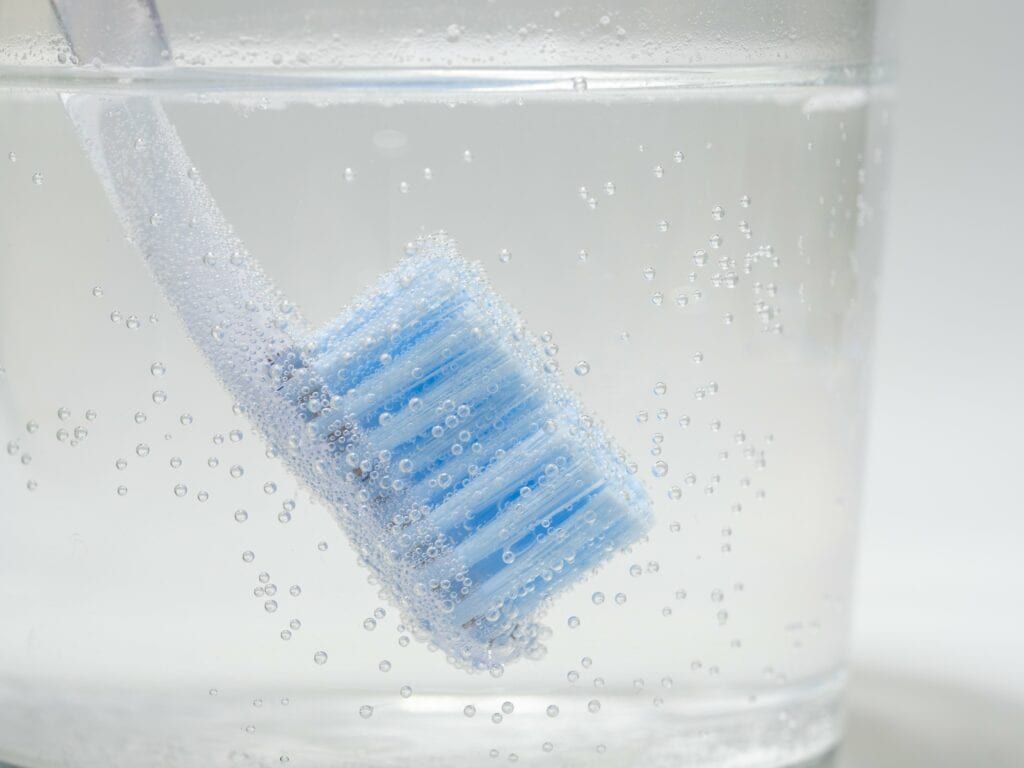According to the American Dental Association, you are recommended to brush your teeth twice every day. Over the course of a year, this adds up to around 730 brushings! The reason why the ADA recommends brushing so often is because plaque and bacteria regularly form on the surface of your teeth. Brushing (and flossing) removes excess plaque and bacteria in order to prevent dental problems like tooth decay and gum disease. But, have you ever wondered where this bacteria goes?

Most of the plaque and bacteria loosened by your toothbrush ends up down the drain with toothpaste after you spit. However, some bacteria remains hidden within the bristles of your toothbrush. Not only that, but most people store their toothbrushes in the bathroom. Unfortunately bathrooms provide a warm, moist environment that causes bacteria to linger in the air. Bacteria from your mouth on your toothbrush + bacteria in the air on your toothbrush = disgusting.
As gross as this sounds, the good news is that it normally does not cause any problems for your oral or overall health. Researchers have found that, yes, your toothbrush does grow various microorganisms, however there is no current evidence that suggests these microorganisms can cause you harm. Nevertheless, excess bacteria can still lead to bad breath and the thought of things growing on your toothbrush can make you less likely to want to stick it in your mouth twice a day. For those reasons, here are a few tips to keeping your toothbrush as clean as possible:
Rinse with Hot Water
Rinsing your toothbrush with hot water before and after brushing your teeth is an easy and effective way to remove excess bacteria. Hot water can kill most types of bacteria that reside on your toothbrush, so rinsing before and after you brush can decrease the amount of bacteria that you are introducing into your mouth every time you brush. Just be careful not to accidentally burn the inside of your mouth.
Soak Your Toothbrush
For some people, the thought of rinsing your toothbrush does not sound like enough. In these cases, you may prefer to soak your toothbrush in an antibacterial mouthwash for about two minutes after you brush. Soaking your toothbrush allows the mouthwash to thoroughly disinfect the bristles of your toothbrush. However, be aware that regularly soaking your toothbrush in mouthwash will cause it to wear down faster, so you will need to replace it more often.

Store in Hydrogen Peroxide
In cases where you are worried about the air quality of your bathroom, you can also opt to store your toothbrush, bristles down, in hydrogen peroxide. Hydrogen can safely and effectively kill existing bacteria on your toothbrush, while preventing the growth of new bacteria. However, using this method means that you will need to use new hydrogen peroxide daily.
Keep Away from the Toilet
While this may seem obvious at first, the fact that many people store their toothbrushes on the bathroom counter suggests otherwise. Every time you flush your toilet, it causes a “toilet plume” which is basically airborne fecal matter. This is one main reason why bathrooms have so much bacteria. To prevent airborne fecal matter from finding its way onto your toothbrush, it is recommended to store your toothbrush in a cabinet or drawer.

Avoid Storing Toothbrushes Together
Another storage mistake that people often make with their toothbrushes is to store multiple toothbrushes together in a cup or container. Unfortunately, storing toothbrushes too close together is almost as bad as sharing toothbrushes. This is because bacteria can easily spread from one toothbrush to another when multiple toothbrushes are touching. If one person is sick, this can also cause the spread of infection. For these reasons, it is recommended to store each toothbrush in its own area where it cannot touch other toothbrushes.
Invest in a Toothbrush Sanitizer
While using the aforementioned strategies are usually enough to control bacterial growth on your toothbrush, there is also the option of purchasing a toothbrush sanitizer. There are different types of sanitizers that use steam and dry heat, an ultraviolet light, or a combination of heat and UV light to disinfect toothbrushes. While the ADA does not believe these are a necessity, they do recommend only using toothbrush sanitizers that are approved by the FDA.
Replace Your Toothbrush
Even when you are doing everything you can to minimize bacterial growth on your toothbrush, you will still need to replace your toothbrush from time to time. In most cases, it is recommended to replace your toothbrush every 3-4 months or when the bristles have become faded or frayed. It is also recommended to replace your toothbrush if you have been sick or if someone else accidentally used your toothbrush.

Dr. Sadati possesses extensive experience in all aspects of advanced restorative dentistry, with an emphasis in cosmetic and implant dentistry. He has attained Accredited Fellow status in the American Academy of Cosmetic Dentistry (AACD), the most rigorous, demanding credentialing process in the world. He is the only AACD Accredited Fellow in South Florida.


